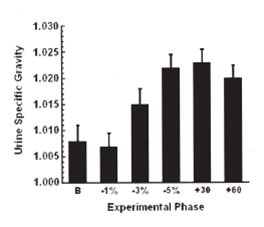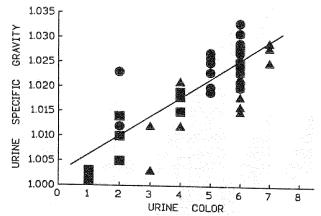We decided to first target hydration monitoring largely because the sensor system would be easy to develop and for quick prototyping of the concept. We did some research on how hydration is currently monitored. As a side note, It has been reported that 70% of Americans are chronically dehydrated so hydration monitoring is a useful tool for the average person.
We looked at two metrics-- specific gravity and urine color.
Specific gravity:
Urine specific gravity, the density of urine compared to water density, is utilized to measure how effectively the kidneys are diluting urine. This metric is commonly used in a clincal setting for determining hydration levels. According to National Collegiate Athletic Association (NCAA), it is he most practical, cost-efficient measurement of hydration status for athletes. For healthy adults, urine specific gravity generally ranges from 1.000 to 1.030 (Urine Specific Gravity).

Figure: The graph shows the effect on specific gravity as an individual is dehydrated from baseline B to 1%, 3%, and 5% less body weight. The last two bars show results after rehydration period of 30 and 60 minutes.
A significant correlation can be seen between urine specific gravity and loss of body weight due to dehydration. Urine specific gravity has been proven to be a reliable and accurate metric for clinical standard hydration assessment.
Urine Color:

Figure: Correlation between urine color and urine specific gravity
Urine color is often used in recreational settings to determine hydration level, is best considered in comparison to each individuals relative normal color. Research has shown the correlation between urine color and other metrics that indicate a persons hydration level. For example, the figure above shows that there is a 0.77-0.96 correlation between urine color and urine specific gravity [Armstrong LE. Hydration assessment techniques. Nutr Rev. 2005;63:S40-S54]. Additionally, studies have shown that a pale yellow color of urine indicates that a person is within 1% of euhydrated body mass. Although color may not have the precision of urine specific gravity, and depends on a variety of factors, when utilized in conjunction with other metrics and in comparison to a patients relative normal, it can be an inexpensive and reliable indicator of hydration [Armstrong].
The two metrics that we incorporated aim to provide hydration information for both clinical and non-clinical settings with a straightforward process that requires no additional usage of chemicals or dipsticks to improve the users ease of experience and reducing cost.
Discussions
Become a Hackaday.io Member
Create an account to leave a comment. Already have an account? Log In.